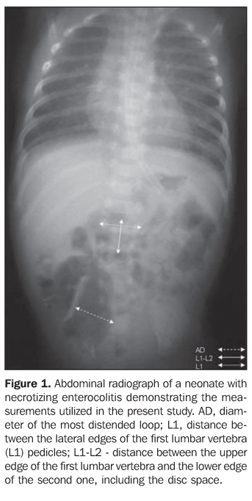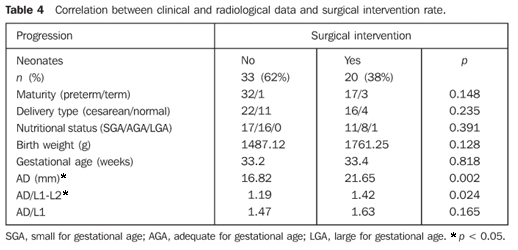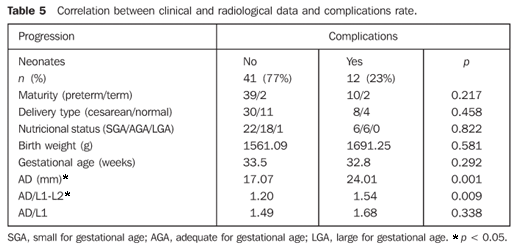Radiologia Brasileira - Publicação Científica Oficial do Colégio Brasileiro de Radiologia
AMB - Associação Médica Brasileira CNA - Comissão Nacional de Acreditação
 Vol. 40 nº 5 - Sep. / Oct. of 2007
Vol. 40 nº 5 - Sep. / Oct. of 2007
|
ORIGINAL ARTICLE
|
|
Dilatation of bowel loops on radiological images: prognostic value in necrotizing enterocolitis |
|
|
Autho(rs): Daniel Lahan Martins, Anderson Gonçalves, Guilherme de Castro Dabus, Joaquim Murray Bustorff-Silva, Hugo Oliveira Olímpio, Beatriz Regina Alvares, Lourenço Sbragia |
|
|
Keywords: Necrotizing enterocolitis, Radiography, Progression |
|
|
Abstract:
INTRODUCTION Necrotizing enterocolitis is the most frequent gastrointestinal emergency occurring in neonates, and the main cause of death due to gastrointestinal diseases in this population. This disease affects 11% of infants weighing less than 1,500 g(1), with mortality rates approaching 40%(2). The group under highest risk includes infants from mothers who have given birth with less than 28 weeks of gestation, and birth weight < 1,000 g(3,4). Considering that the clinical presentation at the initial symptoms onset is variable, a comprehensive workup is required to aid in the decision making process to define therapeutic strategies in case of necrotizing enterocolitis(5-7). Frequently, abdominal radiographs are requested at the admission of patients with symptoms suggesting necrotizing enterocolitis, aiding in the initial steps for the management of the disease. Furthermore, radiographic images provide information on the disease progression, including the detection of necrotizing enterocolitis complications(8,9), as well as forewarning of the risk of intestinal perforation in the presence of distended loops(10,11). The present study was aimed at evaluating the prognostic value of intestinal loops distension evidenced on abdominal radiographs in correlation with the necessity of surgical intervention, occurrence of complications and mortality rate in neonates with necrotizing enterocolitis.
MATERIALS AND METHODS The present prospective study included 54 infants diagnosed with necrotizing enterocolitis, and assisted in the intensive care unit of our institution, in the period between 1995 and 2005, with the previous approval of the Committee for Ethics in Human Research. The necrotizing enterocolitis stages were defined as I, II or III, according to the Bell's criteria, in the presence of symptoms suggesting this disease (Chart 1)(7).
The first abdominal radiograph after the suspicion of necrotizing enterocolitis was performed with the patient in dorsal decubitus, and the image was analyzed by two radiologists. The most distended intestinal loop was identified and its diameter (AD) was measured with a millimeter ruler. Measurements were performed as proposed by Edwards (Table 1)(10), assessing the distance between the upper edge of the first lumbar vertebra and the lower edge of the second one, including the disc space (L1-L2) and the distance between the lateral edges of the first lumbar vertebra (L1) pedicles (Figure 1). Also, the AD/L1-L2 and AD/L1 ratios were calculated.
Such measurements and evaluations were aimed at obtaining absolute values of intestinal loops distension, minimizing differences of height, weight and age, so allowing them to be compared. The site of the most distended loop was classified according to the following anatomical regions: right hypochondrium, left hypochondrium, right flank, left flank, right iliac fossa, and left iliac fossa. Radiological findings were compared among the patients with different outcomes related to the disease progression: necessity of surgical intervention, complications and death. necrotizing enterocolitis complications considered were: intestinal perforation, enteral fistula, dehiscence, colonic stenosis, and necrotizing enterocolitis refractoriness to the treatment(2,11). Measurements were correlated with the Bell's necrotizing enterocolitis staging system at the moment of the diagnostic suspicion in order to minimize other clinical factors interference on the disease prognosis. The non-parametric Kruskal-Wallis test was utilized for statistical analysis to compare two or three groups, and the chi-square test for data organized in 2 × 2 and 3 × 2 tables (statistical significance = p < 0.05).
RESULTS Clinical and radiological data describing the 53 patients with necrotizing enterocolitis are shown on Table 2.
The association between radiological measurements and progression, and Bell's staging system is demonstrated on Table 3. Groups different from Bell's system have presented no variation as regards measurements or progression (p < 0.05).
The correlation between clinical and radiological findings and surgical intervention, complications and death are shown, respectively, on Tables 4, 5 and 6.
The patients submitted to surgery and those with complications presented increase in AD and AD/L1-L2 ratio; patients who progressed to death demonstrated high AD/L1-L2 ratio (p < 0.05). In the group of patients who progressed to surgery, 12 presented complications, and seven died. No significant difference was found in clinical data (maturity, delivery type, nutritional status, birth weight, and gestational age at delivery) and radiographic measurements (AD, AD/L1-L2, AD/L1) among patients who progressed to surgical intervention, those who presented complications and those who progressed do death (p < 0.05). In 16 (30%) patients, the most distended loop was located on the right iliac fossa, in 15 (28%) on the left flank, in 9 (17%) on the left iliac fossa, in 2 (4%) on the right hypochondrium, and in 2 (4%) on the left hypochondrium. No significant association was found between the site of most distended loop and the disease progression (p < 0.05).
DISCUSSION Necrotizing enterocolitis is the first cause of death due to gastrointestinal diseases in neonates, and is characterized by the development of diffuse intestinal necrosis in the preterm neonate submitted to some type of stress(12,13). This disease incidence is inversely related to the gestational age at delivery and birth weight(14,15). Also, age at the symptoms onset is inversely proportional to the gestational age at delivery: the more premature the infant, the longer the necrotizing enterocolitis onset takes to occur(7). The clinical presentation is non-specific, including abdominal distension, hemotochezia, food intolerance, biliary symptoms, circulatory and respiratory instability(5). Between 27% and 63% of neonates with necrotizing enterocolitis require surgical intervention(16). Considering the wide range of symptoms at the moment the necrotizing enterocolitis is suspected, complementary examinations, particularly abdominal radiography, may aid in the identification of neonates with imminent intestinal necrosis and neonates requiring immediate surgical intervention for minimizing complications(8,17). The presence of generalized intestinal distension is a relevant sign for an early diagnosis, and distended loops distribution is important in the evaluation of the disease progression. Both findings constitute key radiological elements in the diagnosis of necrotizing enterocolitis(18). Not always intramural gas and gas in the portal system are associated with the disease severity. Also, not always the disappearance of these symptoms means a clinical recovery(19). There is no review article demonstrating radiographic findings in patients with symptoms suggesting necrotizing enterocolitis and its association with their prognosis. Wexler has studied five neonates with necrotizing enterocolitis, and has suggested that neonates with a persistently distended loop were considered as candidates for laparotomy. On the other hand, Leonard et al. have measured loops in 21 neonates with necrotizing enterocolitis and correlated with surgical indication. None of the authors has correlated the distended loop measurement with the disease prognosis (20,21). Pneumoperitoneum and free intraperitoneal fluid, as well as persistently distended loop (sentinel loop sign) found in consecutive radiographic evaluations constitute radiological indication for surgery(22). Abdominal radiography is an important tool in the necrotizing enterocolitis diagnosis(10,23). Measurements of the most distended loop may be reliable indicators of necrotizing enterocolitis when its diameter is similar to the measurement of the L1 vertebra(10). The results of the present study demonstrated that measurements performed on abdominal radiographs confirm numerically the subjective impression of clinical experiments that distended loops are related to a poorer prognosis. Neonates with unfavorable progression (those who required surgical intervention, underwent complications or died) demonstrated intestinal loops more distended on abdominal radiograph at the moment of their admission for suspicion of necrotizing enterocolitis. Notwithstanding, it is necessary to be careful, especially with preterm neonates with intestinal distension secondary to positive-pressure ventilatory assistance, considering that in these cases this finding does not necessarily imply severity of the patients' clinical condition(8). Neonates submitted to surgery presented AD and AD/L1-L2, respectively 29% and 20% higher than those who have not been submitted to surgery (p < 0.05). Neonates with complications presented AD and AD/L1-L2, respectively, 40% and 28% higher, in comparison with those with no complication (p < 0.05). Additionally, neonates who progressed to death presented AD/L1-L2 24% higher than those who survived (p < 0.05). These neonates did not presented any other disease or clinical alteration, so no influence of these factors was present on the results of radiographic measurements. In spite of the absence of a statistically significant difference, the right iliac fossa was the most frequent site of the most distended loop (30%), which may be explained by the difficulty of collateral circulation in the ileum-terminal region(24,25). As regards neonates fitting into the same stage of the Bell's system, and presenting with different disease progression, a statistically significant difference was observed between radiographic measurements only in some groups, possibly because the small sampling size of our series. The Bell's necrotizing enterocolitis staging system, besides representing a clinical guidance added to the evaluation of the intestinal distention degree on abdominal radiographs, may aid in the definition of the disease prognosis, considering that, at stages I and II, the presence of a significant intestinal distention increases the suspicion of the disease severity(10,26). Neonates requiring surgical intervention presented with intestinal loops measuring more than 21 mm (p < 0,05), while those who developed additional complications presented with intestinal loops measuring more than 24 mm (p < 0,05).
CONCLUSION The measurement of the most dilates bowel loop in association with AD/L1-L2 on abdominal radiographs is a simple, non-expensive and easily reproducible method that adds diagnostic and prognostic information regarding surgical outcomes and complications in patients with necrotizing enterocolitis.
REFERENCES 1. Uauy RD, Fanaroff AA, Korones SB, Phillips EA, Phillips JB, Wright LL. Necrotizing enterocolitis in very low birth weight infants: biodemographic and clinical correlates. National Institute of Child Health and Human Development Neonatal Research Network. J Pediatr 1991;119:630–638. [ ] 2. Neu J. Neonatal necrotizing enterocolitis: an update. Acta Paediatr Suppl 2005;94:100–105. [ ] 3. Chandler JC, Hebra A. Necrotizing enterocolitis in infants with very low birth weight. Semin Pediatr Surg 2000;9:63-72. [ ] 4. Hack M, Wright LL, Shankaran S, et al. Very-low-birth-weight outcomes of the National Institute of Child Health and Human Development Neonatal Network, November 1989 to October 1990. Am J Obstet Gynecol 1995;172:457–464. [ ] 5. Foglia RP. Necrotizing enterocolitis. Curr Probl Surg 1995;32:757–823. [ ] 6. Pellegrini M, Lagrasta N, García García C, Campos Serna J, Zicari E, Marzocca G. Neonatal necrotizing enterocolitis: a focus on. Eur Rev Med Pharmacol Sci 2002;6:19-25. [ ] 7. Bell MJ, Temberg JL, Feigin RD, et al. Neonatal necrotizing enterocolitis. Therapeutic decisions based upon clinical staging. Ann Surg 1978;187:1-7. [ ] 8. Buonomo C. The radiology of necrotizing enterocolitis. Radiol Clin North Am 1999;37:1187–1198, VII. [ ] 9. Molik KA, West KW, Rescorla FJ, Scherer LR, Engum SA, Grosfeld JL. Portal venous air: the poor prognosis persists. J Pediatr Surg 2001;36:1143-1145. [ ] 10. Edwards DK. Size of gas-filled bowel loops in infants. AJR Am J Roentgenol 1980;135:331-334. [ ] 11. Nowick, PT. Ischemia and necrotizing enterocolitis: where, when and how. Semin Pediatr Surg 2005;14:152-158. [ ] 12. Pierro A. The surgical management of necrotising enterocolitis. Early Hum Dev 2005;81:79-85. [ ] 13. Hackam DJ, Upperman JS, Grishin A, Ford HR. Disordered enterocyte signaling and intestinal barrier dysfunction in the pathogenesis of necrotizing enterocolitis. Semin Pediatr Surg 2005;14:49-57. [ ] 14. Covert RF, Neu J, Elliot MJ, Rea JL, Gimotty PA. Factors associated with age of onset of necrotizing enterocolitis. Am J Perinatol 1989;6:455-460. [ ] 15. Stoll BJ. Epidemiology of necrotizing enterocolitis. Clin Perinatol 1994;21:205-218. [ ] 16. Ricketts RR. Surgical treatment of necrotizing enterocolitis and the short bowel syndrome. Clin Perinatol 1994;21:365-387. [ ] 17. Gómez Tellado M, García Fernández E, País Piñeiro E, et al. Necrotizing enterocolitis: a 10-year survey. Cir Pediatr 1995;8:20-23. [ ] 18. Daneman A, Woodward S, de Silva M. The radiology of neonatal necrotizing enterocolitis (NEC). A review of 47 cases and the literature. Pediatr Radiol 1978;7:70-77. [ ] 19. Sharma R, Tepas JJ 3rd, Hudak ML, et al. Portal venous gas and surgical outcome of neonatal necrotizing enterocolitis. J Pediatr Surg 2005;40:371–376. [ ] 20. Wexler HA. The persistent loop sign in neonatal necrotizing enterocolitis: a new indication for surgical intervention? Radiology 1978;126:201-204. [ ] 21. Leonard T Jr, Johnson JF, Pettett PG. Critical evaluation of the persistent loop sign in necrotizing enterocolitis. Radiology 1982;142:385-386. [ ] 22. Kosloske AM. Indications for operation in necrotizing enterocolitis revisited. J Pediatr Surg 1994;29:663-666. [ ] 23. Kogutt MS. Necrotizing enterocolitis of infancy. Early roentgen patterns as a guide to prompt diagnosis. Radiology 1979;130:367-370. [ ] 24. Lee JS, Polin RA. Treatment and prevention of necrotizing enterocolitis. Semin Neonatol 2003;8:449-459. [ ] 25. Birnbaum BA, Jeffrey RB Jr. CT and sonographic evaluation of acute right lower quadrant abdominal pain. AJR Am J Roentgenol 1998;170:361-371. [ ] 26. Roy A, Tayeb M, Al-Khogeer S. Outcome in definite and advanced neonatal necrotizing enterocolitis. Saudi Med J 2004;25:746-752. [ ]
Received December 5, 2006. Accepted after revision April 9, 2007.
* Study developed at Department of Radiology and Department of Surgery, Faculdade de Ciências Médicas da Universidade Estadual de Campinas (FCM-Unicamp), Campinas, SP, Brazil. |
|
Av. Paulista, 37 - 7° andar - Conj. 71 - CEP 01311-902 - São Paulo - SP - Brazil - Phone: (11) 3372-4544 - Fax: (11) 3372-4554








